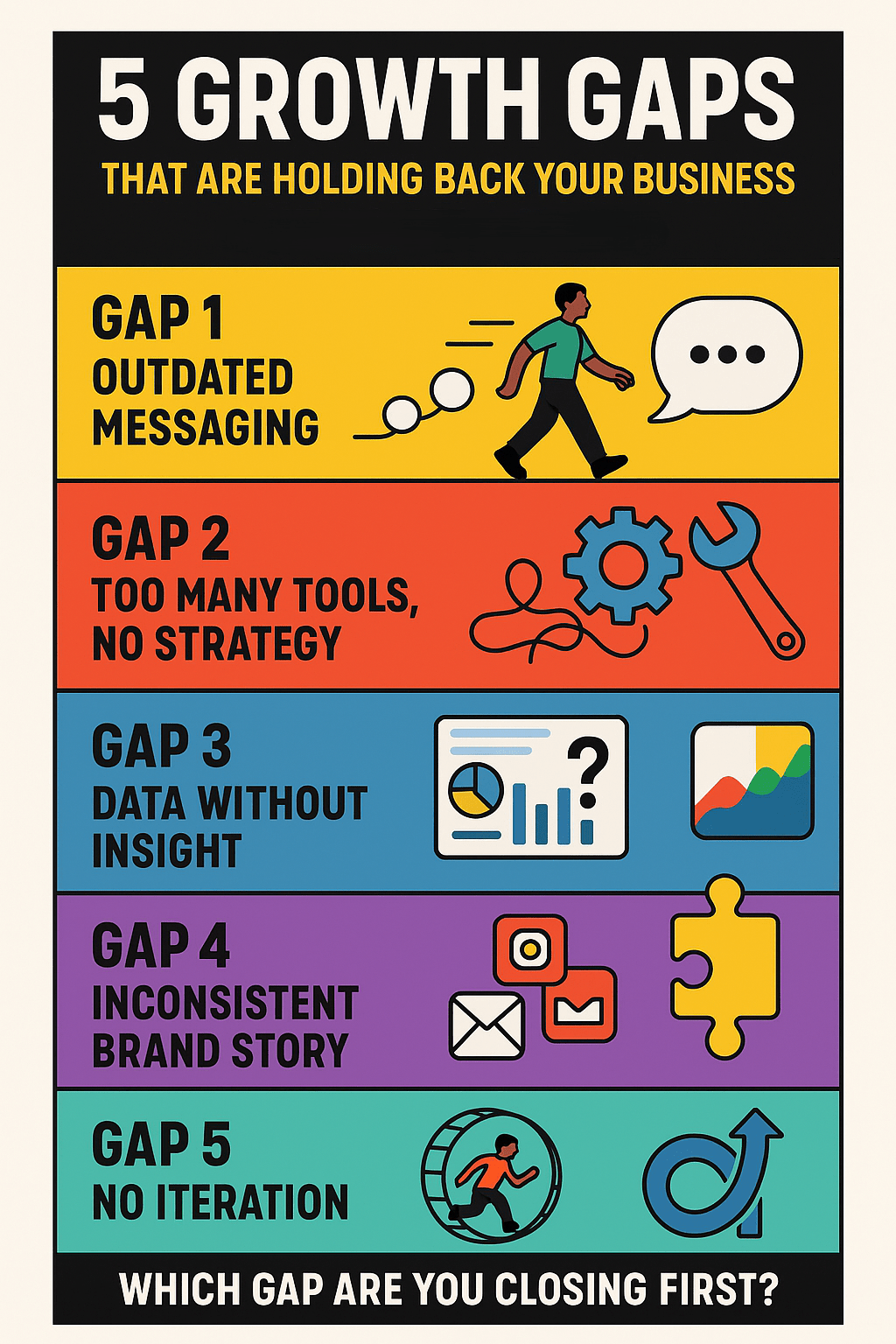
There’s a big difference between a marketing strategy that looks good on paper and one that actually delivers results.
Your dashboard says everything’s “fine.” Posts are going out. Ads are running. Funnels are technically functional. But something still feels off. Leads are inconsistent. Conversions dip without explanation. And momentum? It’s just not there.
This slow decline rarely stems from a single, obvious misstep. It’s usually the result of quiet, overlooked gaps. Not the kind that screams for attention, but the kind that gradually chips away at performance until your growth stalls.
These gaps don’t only show up in entry-level marketing teams. Even the most experienced operators hit this wall. Everything is moving, but nothing is truly working the way it should.
The key is learning how to spot—and fix—these friction points before they start costing you more time, money, and opportunity.
Let’s dig in.
Why the Data Isn’t Telling You the Full Story
Most analytics platforms track activity, not alignment. Clicks, opens, bounce rates, and impressions are all helpful, but they don’t explain why performance feels disconnected.
One campaign might show solid engagement but deliver zero qualified leads. Another may underperform by the numbers yet attract high-value customers. Without context, even “good” data can be misleading.
Gaps in strategy live in those blind spots: where messaging misfires, timing is off, or customer experience feels fragmented.
Fixing them isn’t about layering on more tactics. It’s about refining what’s already in place—and making it work better.
5 Growth Gaps You Can’t Afford to Ignore
Gap #1: You’ve Outgrown Your Own Messaging
Your business has evolved, but your messaging hasn’t caught up.
It’s one of the most common—and costly—gaps. The language that once resonated no longer lands because your audience has matured or shifted focus. And what used to be urgent might now feel irrelevant.
Here’s how to spot the mismatch:
- Are you still solving yesterday’s problems instead of today’s?
- Is your copy speaking to where your customers were, not where they are now?
- Do your emails, landing pages, and sales messaging still feel fresh, clear, and relevant?
When your messaging doesn’t meet the moment, even your best offers fall flat.
Gap #2: You’ve Got the Tools—But Not the Strategy
CRMs, automation platforms, AI writers, and ad tools can all be powerful, but without a system that connects them with purpose, they create complexity instead of clarity.
Ask yourself:
- What outcome is this tool helping us achieve?
- Where in the customer journey is this improving the experience?
- Could we simplify our workflow without losing effectiveness?
Often, the fix isn’t about adding more—it’s about removing what no longer adds value.
Gap #3: You’re Collecting Data—But Missing Insight
Dashboards full of data don’t automatically lead to better decisions.
If you’re seeing the “what” (drop-offs, bounces, click-through rates) but not understanding the “why,” you’re stuck in a data gap. A strategy built on partial understanding often leads to wasted budget and misaligned campaigns.
Try this:
- Use heatmaps or session recordings to observe real user behavior.
- Run short user interviews to understand motivations and objections.
- Segment based on behavior and intent, not just basic demographics.
When you start connecting the dots between numbers and human behavior, your strategy becomes a lot more accurate—and a lot more effective.
Gap #4: Every Channel Tells a Different Story
If your Instagram, emails, and website all sound like they come from different companies, you’ve got a brand inconsistency problem.
It’s not about matching fonts or using the same headlines everywhere. It’s about strategic cohesion. When each channel tells a piece of the same story, trust builds. When they feel disconnected, confidence drops.
Consider:
- Is your message, tone, and offer aligned across touchpoints?
- Does each platform clearly reinforce your core positioning?
- Can a customer go from ad to landing page to email without feeling a disconnect?
Disjointed storytelling costs you conversions. Alignment multiplies them.
Gap #5: You’re Executing—but Not Iterating
Consistency is good. Complacency? Not so much.
If you’re consistently posting, emailing, or launching—but growth has stalled—you may be running a strategy stuck in maintenance mode.
Just because something works “okay” doesn’t mean it couldn’t work better. Strategic iteration—small, smart improvements over time—is where the real growth happens.
Ask:
- When was the last time your funnel was pressure-tested?
- Are your CTAs converting—or just existing?
- Have you run a real A/B test in the past 30 days?
If nothing’s been optimized in months, there’s an opportunity sitting right under your nose.
How To Uncover and Fix These Gaps
The good news? You don’t need to blow everything up and start over. You just need a sharper lens and a smarter process.
Here’s how to start closing the right gaps—with real, actionable steps:
1. Run a Relevance Audit
Pull up your sales page, email automation, or service overview. Don’t look at it as the creator—look at it like a customer seeing it for the first time.
Action Step:
Ask:
- Does this solve a problem they still care about?
- Does the language match the way they talk?
- Would a stranger “get it” in 8 seconds or less?
Highlight outdated phrases, assumptions, or offers—and update them to reflect today’s urgency, tone, and clarity.
2. Set Up a Feedback Loop
Raw, real-time feedback reveals friction fast. Don’t wait for surveys—catch moments when emotion or momentum is highest.
Action Step:
Add a simple feedback prompt after opt-ins or purchases:
- “What almost stopped you from signing up?”
- “Was anything confusing or frustrating?”
You’ll uncover messaging gaps, UX issues, and micro-objections that analytics can’t show you.
3. Review Your Tech Stack with Purpose
An overbuilt system slows down both teams and results. Every tool should serve a measurable purpose—if it doesn’t, it’s probably in the way.
Action Step:
List every platform you use. Next to each, write:
- What it’s supposed to do
- How often is it used
- What metrics does it support (lead gen, conversion, retention, etc)
Cut what’s not actively driving outcomes—or simplify where overlaps exist.
4. Seek Fresh Perspective
Sometimes, you’re too close to see what’s broken.
Action Step:
Record yourself walking through your lead capture flow or sales process. Narrate your thoughts as if you’re a first-time visitor. Then send it to someone outside your business and ask:
- What feels unclear or clunky?
- What did you expect that didn’t happen?
- Where would you bounce?
You’ll spot trust-breakers and drop-off points almost immediately.
Let’s Close the Gaps and Build a Strategy That Performs
Digital marketing isn’t about doing more. It’s about doing what actually works.
When your message is clear, your systems are aligned, and your decisions are rooted in real insight, you stop wasting effort and start building momentum.
If things feel stuck, inconsistent, or overly complex, it’s probably not a capacity issue. It’s a clarity issue.
And if a fresh perspective or some strategic support would help? Monetized Marketing is here to help point you in the right direction.

